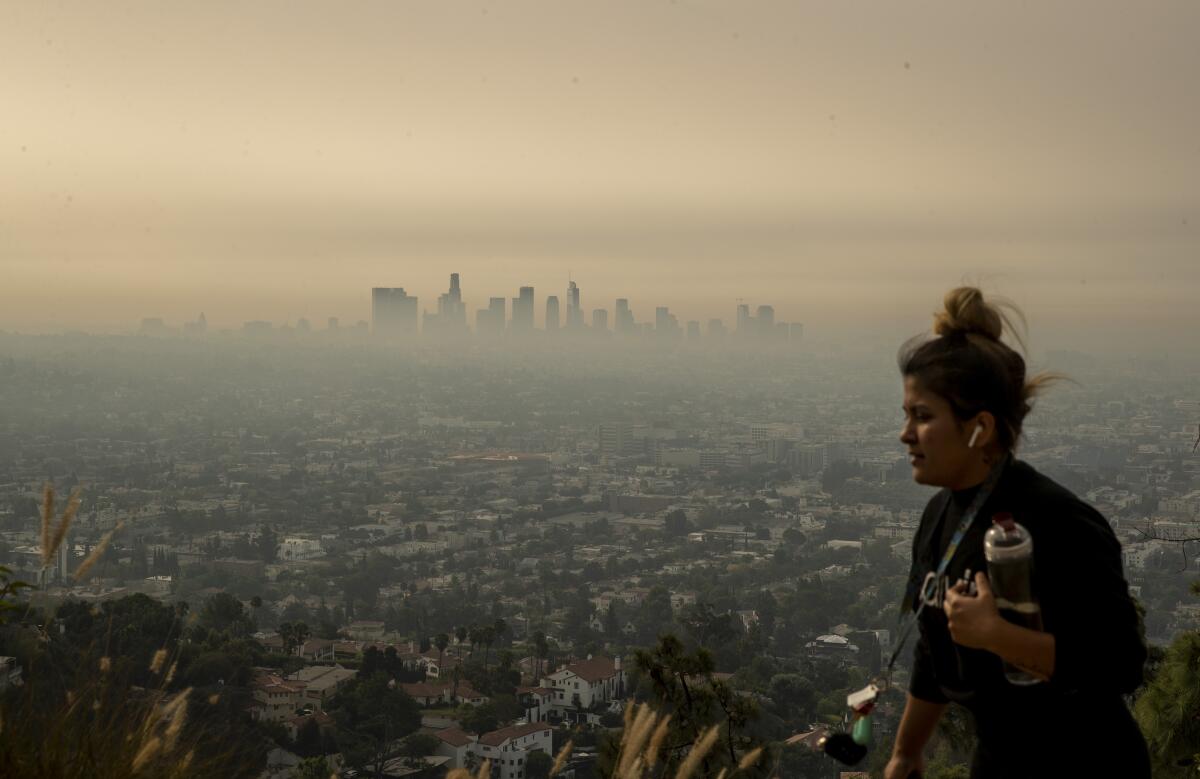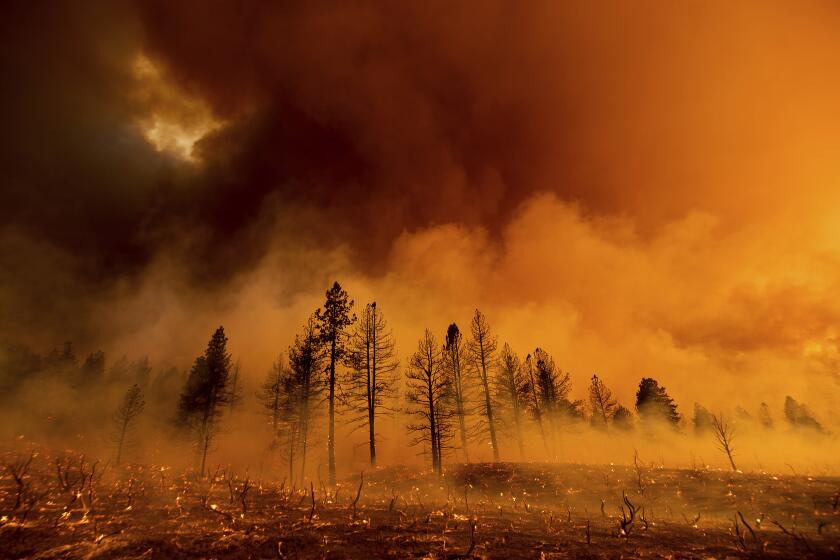Air purifiers are in demand as COVID-19 collides with wildfire season. What buyers should know

- Share via
Between COVID-19’s airborne transmission and more recently choking smoke sent aloft by Western wildfires — some of which drifted thousands of miles to settle over East Coast cities — the very air Americans breathe has gone from afterthought to worrisome threat.
One sector that’s managed to benefit from these dual crises is the air purifier industry. Sales have been climbing since the onset of the pandemic in 2020, a trend that’s been turbocharged this year by unprecedented, climate change-induced infernos raging across the West.
Researchers who spend their days thinking about air quality say some purifiers can be an effective way to make inside air cleaner — and that when it comes to the coronavirus, potentially help lower risk of transmission — when coupled with other, traditional precautions.
The air treatment systems market is expected to expand by 29% this year, according to research and consulting firm Verify Markets, driven in part by the spreading Delta variant of COVID-19 and smoke from wildfires in the West. It follows a growth rate of 57% in 2020, when Americans rushed to buy anything that they thought might prevent them from getting infected.
This year, when it comes to the consequences of Western wildfires, Environmental Defense Fund air pollution specialist Maria Harris said “there’s no place in the U.S. not potentially vulnerable.”
As long as users follow certain guidelines and don’t get swayed by hyperbolic marketing claims, portable purifiers can be helpful in dealing with poor air quality. And you won’t necessarily have to shell out thousands of dollars to get a solid machine.
In the U.S., search-engine queries for related terms have jumped over the past month, with the phrase “air purifier for smoke” becoming 140% more popular, according to Google Trends. Unsurprisingly, interest appeared stronger in the Northwest, where fires have been terrible this summer. But it was also robust across the country in places such as Mississippi, underscoring the broad-ranging impact of the disasters.
Wildfire smoke has been linked to a range of negative health effects, including asthma attacks and more susceptibility to respiratory infections, Harris said.
That’s “particularly concerning in the context of the COVID-19 pandemic,” she said. “The pollutants in smoke can harm health in many different ways, so anything we can do to reduce exposure is a good idea.”
As wildfires ravage hundreds of thousands of acres across California, more is being learned about the damaging effects of their smoke.
What to look for in a purifier
Choosing a product, however, can seem daunting with so many brands and models on the market. The first step is ensuring the purifier has a high efficiency particulate air filter, most commonly known as HEPA, according to Lew Harriman, the retired director of research at consulting firm Mason-Grant.
When it comes to combating the spread of the coronavirus, Illinois Institute of Technology engineering professor Brent Stephens said the empirical evidence supporting air purifiers is newer and less concrete. But he added that he believes they can be helpful. He highlighted a July report from the U.S. Centers for Disease Control and Prevention, which found in a study performed this year that a HEPA air cleaner can reduce exposure to COVID-19 indoors, particularly when combined with masking.
Stephens normally avoids add-ons such as ionization systems aimed at inactivating viruses, because the literature on them is limited, he said. Moreover, he said there’s some indication these technologies could prove counterproductive. Some HEPA models include such features, which he just turns off.
He does recommend checking an air purifier’s clean-air delivery rate, an industry standard that helps measure efficacy. The higher the rate, the more particles the unit can filter and the larger area it can serve, according to the U.S. Environmental Protection Agency. For wildfire smoke, users might want to buy a model that filters out odors in addition to pollutants, Stephens said. Harris, with the Environmental Defense Fund, also advises scanning third-party effectiveness tests.
To make sure people are getting clean air wherever they are in the home, Harriman suggests buying several small purifiers and scattering them around the house — which could also come at a lower cost than buying a larger machine. It’s more effective to be near a working air purifier when inside, he said, rather than rely on the reach of a big one in another room.
Overall, there’s no need to spend a fortune, either. Some “workhorse models” cost around $500 to $600, Stephens said, but it’s also possible to get “really good products” for $200 to $300. The price will of course depend on what’s available in a particular area and whether others are also rushing to buy the appliances.
Reliable HEPA cleaners include those made by Blueair AB, Honeywell International Inc. and Coway Co., among others, Harriman said. In the past three months, Coway purifier sales increased by 102.8% compared to the same period in 2020, spokesperson Jordan Weintraub said in an email. The company usually sees a spike when air quality worsens amid wildfires.
Harris said she’s experienced the reassurance air purifiers provide in reducing pollution on smoky days, in terms of how the atmosphere in her house feels and smells. But she notes that relying on appliances to deal with the threat posed by a deadly pathogen or fallout from global warming is not a long-term strategy.
Many people “lack the resources to make purchases like private air purifiers to help reduce their exposure,” Harris said. “There are societal solutions needed here, very clearly.”
More to Read
Inside the business of entertainment
The Wide Shot brings you news, analysis and insights on everything from streaming wars to production — and what it all means for the future.
You may occasionally receive promotional content from the Los Angeles Times.











